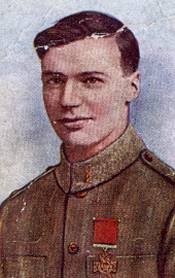Leo Clarke (VC): Difference between revisions
m Reverted edits by 142.227.211.1 (talk) to last revision by Vrenator (HG) |
Tag: possible vandalism |
||
| Line 4: | Line 4: | ||
==Early life== |
==Early life== |
||
Clarke was born in [[Waterdown, Ontario]]. He spent his early years in [[England]], home of his parents, but later returned and settled in [[Winnipeg, Manitoba]] in about 1903. When [[World War I]] started, he was working as a surveyor for the [[Canadian National Railway]] in the Canadian north. He returned to Winnipeg to enlist in the [[27th Battalion, CEF|27th Battalion]], and after arriving in England in June 1915, transferred to the [[2nd (Eastern Ontario Regiment) Battalion, CEF|2nd (Eastern Ontario Regiment) Battalion]], [[Canadian Expeditionary Force]] to be with his brother, Charles. |
Clarke was born in [[Waterdown, Ontario]]. He spent his early years in [[England]], home of his parents, but later returned and settled in [[Winnipeg, Manitoba]] in about 1903. When [[World War I]] started, he was working as a surveyor for the [[Canadian National Railway]] in the Canadian north. He returned to Winnipeg to enlist in the [[27th Battalion, CEF|27th Battalion]], and after arriving in England in June 1915, transferred to the [[2nd (Eastern Ontario Regiment) Battalion, CEF|2nd (Eastern Ontario Regiment) Battalion]], [[Canadian Expeditionary Force]] to be with his brother, Charles. |
||
gram loves madison |
|||
==Victoria Cross== |
==Victoria Cross== |
||
Revision as of 16:02, 26 October 2011

Leo Clarke, VC (December 1, 1892 – October 19, 1916) was a Canadian recipient of the Victoria Cross, the highest and most prestigious award for gallantry in the face of the enemy that can be awarded to British and Commonwealth forces.
Early life
Clarke was born in Waterdown, Ontario. He spent his early years in England, home of his parents, but later returned and settled in Winnipeg, Manitoba in about 1903. When World War I started, he was working as a surveyor for the Canadian National Railway in the Canadian north. He returned to Winnipeg to enlist in the 27th Battalion, and after arriving in England in June 1915, transferred to the 2nd (Eastern Ontario Regiment) Battalion, Canadian Expeditionary Force to be with his brother, Charles. gram loves madison
Victoria Cross
The main assault of the Battle of Flers-Courcelette was scheduled for September 15, 1916. Its objective was to occupy a chain of trenches between Martinpuich and Courcelette. On September 1, 1916, Clarke's battalion was charged with capturing a 50-yard-long salient between the Canadian position at Mouquet Farm and Courcelette to the north.
On September 9, 1916, near Pozieres, France, the first three companies of Clarke's battalion went over the top, leaving the fourth in reserve. Clarke, an Acting Corporal at the time, was assigned to take a section to clear the enemy on the left flank to allow his company sergeant to build a fortified dugout that would secure the Canadian position once the salient was overrun. When his section reached the trench, it was so heavily defended that they had to battle their way through with hand grenades, bayonets and their rifles as clubs. Clarke was the only man left standing; the rest had either been killed or wounded.
At that time, about 20 Germans, including two officers, counter-attacked. Clarke advanced, emptying his revolver into them. He then picked up two enemy rifles and fired those too. One of the officers attacked with a bayonet, wounding Clarke in the leg, but Clarke shot him dead. The Germans retreated, but Clarke pursued, shooting four more and capturing a fifth. In all, Clarke killed 19 of the enemy, capturing one.
Death

On October 11, 1916, Clarke's battalion was ordered forward to secure the newly captured Regina Trench which was still under heavy enemy artillery fire. Clarke was crouching in a hole at the rear of a trench when a shell exploded and the back of the trench caved in, burying him. His brother dug him out, but Clarke was paralyzed; the weight of the earth had crushed his back and injured his spine. Clarke was taken to No. 1 General Hospital, but died on October 19. He is buried in Plot II, Row C, Grave 3A, in Etretat Churchyard, 16 miles north of Le Havre, France. According to a contemporary newspaper article, shortly before his death he wrote his parents, stating: "I don't care so much for the V.C. as getting home for a couple of months."
Legacy
Clarke was posthumously awarded the Victoria Cross in the spring of 1917. It was presented, by the Duke of Devonshire (Governor General of Canada in 1917), to Leo's father before a crowd of 30,000. This was the first time the VC had been presented to a commonwealth recipient in his own country.
In 1925, Pine Street in Winnipeg was renamed "Valour Road" in honor of Clarke and fellow Victoria Cross winners Frederick William Hall and Robert Shankland, all of whom lived on the 700 block. A plaque in his honor was erected by the Ontario Heritage Foundation at the Royal Canadian Legion branch in Waterdown.
Clarke's story was featured in a Historica vignette, which was run nationally in Canada.
References
- "Flamboro Boy Winner of the Victoria Cross" - Hamilton Spectator, October 27, 1916, p.1
- Monuments to Courage (David Harvey, 1999)
- Scotland's Forgotten Valour (Graham Ross, 1995)
- The Register of the Victoria Cross (This England, 1997)
- VCs of the First World War - The Somme (Gerald Gliddon, 1994)
External links
- LEO CLARKE (service/personal details, citation, relevant documents, burial information)
- Historica vignette
- Legion Magazine article on Leo Clarke
- Find-A-Grave profile for Leo Clarke
- Ontario Historic Plaque
